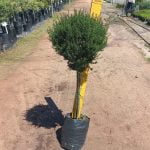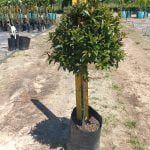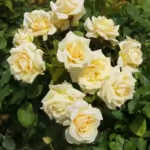Showing 1–12 of 85 resultsSorted by popularity
-

Zulu Royal Rose STD 90cm
R305.00Add to cartZulu Royal Rose STD 90cm
Full Sun
Afternoon Sun
Moderate Watering
Monthly Feeding
Prune in WinterStandard roses, also known as lollipop roses, are a form of rose plant that is trained to have a long, straight trunk or stem with a rounded canopy of foliage and flowers at the top.
They are often used as standalone specimens in gardens or as focal points in landscaping.Growth habit
Standard roses are typically grafted plants where a desirable rose variety, known as the “scion,” is grafted onto a tall, straight stem of a different rose species or rootstock.
The stem is trained to grow straight and upright, creating a clear trunk without any side branches until it reaches a specific height.
At the top, the scion forms a rounded head or canopy of foliage and flowers.Height and size
The overall height of standard roses can vary depending on the desired size and how they are pruned.
Generally, standard roses can reach a height of 1 to 2m, with the canopy or head taking up a significant portion of the overall height.Pruning and maintenance
Regular pruning is essential to maintain the shape and size of standard roses. Pruning is typically done in early spring or late winter, before new growth emerges.
It involves removing dead, damaged, or weak wood, as well as shaping the canopy by selectively pruning the side branches.Flowering
Standard roses produce flowers at the top of the canopy, just like other rose varieties.
The flowers can come in various colors, forms, and fragrances, depending on the specific rose variety used as the scion.
They often bloom during the growing season, providing a beautiful display of color and fragrance.Uses
Standard roses are versatile and can be used in different garden settings. They are commonly planted in borders, formal gardens, or as standalone specimens in containers or garden beds.
Due to their vertical stature and the visual impact of the rounded canopy of flowers, they can serve as focal points in landscapes or create a dramatic effect when planted in groups.Varieties
Many rose varieties can be trained as standards, allowing for a wide selection of flower colors, forms, and fragrances.
Popular rose varieties often used as standard roses include hybrid teas, floribundas, and grandifloras.Standard roses, or lollipop roses, are eye-catching additions to gardens and landscapes. Their elegant form, long stems, and rounded canopy of flowers create a unique visual appeal.
With proper care, pruning, and attention, standard roses can bring vertical interest and beauty to any outdoor space. -

Iceberg Rose STD 90cm
R305.00Add to cartIceberg Rose STD 90cm
Full Sun
Afternoon Sun
Moderate Watering
Monthly Feeding
Prune in WinterStandard roses, also known as lollipop roses, are a form of rose plant that is trained to have a long, straight trunk or stem with a rounded canopy of foliage and flowers at the top.
They are often used as standalone specimens in gardens or as focal points in landscaping.Growth habit
Standard roses are typically grafted plants where a desirable rose variety, known as the “scion,” is grafted onto a tall, straight stem of a different rose species or rootstock.
The stem is trained to grow straight and upright, creating a clear trunk without any side branches until it reaches a specific height.
At the top, the scion forms a rounded head or canopy of foliage and flowers.Height and size
The overall height of standard roses can vary depending on the desired size and how they are pruned.
Generally, standard roses can reach a height of 1 to 2m, with the canopy or head taking up a significant portion of the overall height.Pruning and maintenance
Regular pruning is essential to maintain the shape and size of standard roses. Pruning is typically done in early spring or late winter, before new growth emerges.
It involves removing dead, damaged, or weak wood, as well as shaping the canopy by selectively pruning the side branches.Flowering
Standard roses produce flowers at the top of the canopy, just like other rose varieties.
The flowers can come in various colors, forms, and fragrances, depending on the specific rose variety used as the scion.
They often bloom during the growing season, providing a beautiful display of color and fragrance.Uses
Standard roses are versatile and can be used in different garden settings. They are commonly planted in borders, formal gardens, or as standalone specimens in containers or garden beds.
Due to their vertical stature and the visual impact of the rounded canopy of flowers, they can serve as focal points in landscapes or create a dramatic effect when planted in groups.Varieties
Many rose varieties can be trained as standards, allowing for a wide selection of flower colors, forms, and fragrances.
Popular rose varieties often used as standard roses include hybrid teas, floribundas, and grandifloras.Standard roses, or lollipop roses, are eye-catching additions to gardens and landscapes. Their elegant form, long stems, and rounded canopy of flowers create a unique visual appeal.
With proper care, pruning, and attention, standard roses can bring vertical interest and beauty to any outdoor space. -

Ingrid Bergman Rose STD 90cm
R305.00Add to cartIngrid Bergman Rose STD 90cm
Full Sun
Afternoon Sun
Moderate Watering
Monthly Feeding
Prune in WinterStandard roses, also known as lollipop roses, are a form of rose plant that is trained to have a long, straight trunk or stem with a rounded canopy of foliage and flowers at the top.
They are often used as standalone specimens in gardens or as focal points in landscaping.Growth habit
Standard roses are typically grafted plants where a desirable rose variety, known as the “scion,” is grafted onto a tall, straight stem of a different rose species or rootstock.
The stem is trained to grow straight and upright, creating a clear trunk without any side branches until it reaches a specific height.
At the top, the scion forms a rounded head or canopy of foliage and flowers.Height and size
The overall height of standard roses can vary depending on the desired size and how they are pruned.
Generally, standard roses can reach a height of 1 to 2m, with the canopy or head taking up a significant portion of the overall height.Pruning and maintenance
Regular pruning is essential to maintain the shape and size of standard roses. Pruning is typically done in early spring or late winter, before new growth emerges.
It involves removing dead, damaged, or weak wood, as well as shaping the canopy by selectively pruning the side branches.Flowering
Standard roses produce flowers at the top of the canopy, just like other rose varieties.
The flowers can come in various colors, forms, and fragrances, depending on the specific rose variety used as the scion.
They often bloom during the growing season, providing a beautiful display of color and fragrance.Uses
Standard roses are versatile and can be used in different garden settings. They are commonly planted in borders, formal gardens, or as standalone specimens in containers or garden beds.
Due to their vertical stature and the visual impact of the rounded canopy of flowers, they can serve as focal points in landscapes or create a dramatic effect when planted in groups.Varieties
Many rose varieties can be trained as standards, allowing for a wide selection of flower colors, forms, and fragrances.
Popular rose varieties often used as standard roses include hybrid teas, floribundas, and grandifloras.Standard roses, or lollipop roses, are eye-catching additions to gardens and landscapes. Their elegant form, long stems, and rounded canopy of flowers create a unique visual appeal.
With proper care, pruning, and attention, standard roses can bring vertical interest and beauty to any outdoor space. -

Pearl of Bedfordview Rose STD 90cm
R305.00Add to cartPearl of Bedfordview Rose STD 90cm
Full Sun
Afternoon Sun
Moderate Watering
Monthly Feeding
Prune in WinterStandard roses, also known as lollipop roses, are a form of rose plant that is trained to have a long, straight trunk or stem with a rounded canopy of foliage and flowers at the top.
They are often used as standalone specimens in gardens or as focal points in landscaping.Growth habit
Standard roses are typically grafted plants where a desirable rose variety, known as the “scion,” is grafted onto a tall, straight stem of a different rose species or rootstock.
The stem is trained to grow straight and upright, creating a clear trunk without any side branches until it reaches a specific height.
At the top, the scion forms a rounded head or canopy of foliage and flowers.Height and size
The overall height of standard roses can vary depending on the desired size and how they are pruned.
Generally, standard roses can reach a height of 1 to 2m, with the canopy or head taking up a significant portion of the overall height.Pruning and maintenance
Regular pruning is essential to maintain the shape and size of standard roses. Pruning is typically done in early spring or late winter, before new growth emerges.
It involves removing dead, damaged, or weak wood, as well as shaping the canopy by selectively pruning the side branches.Flowering
Standard roses produce flowers at the top of the canopy, just like other rose varieties.
The flowers can come in various colors, forms, and fragrances, depending on the specific rose variety used as the scion.
They often bloom during the growing season, providing a beautiful display of color and fragrance.Uses
Standard roses are versatile and can be used in different garden settings. They are commonly planted in borders, formal gardens, or as standalone specimens in containers or garden beds.
Due to their vertical stature and the visual impact of the rounded canopy of flowers, they can serve as focal points in landscapes or create a dramatic effect when planted in groups.Varieties
Many rose varieties can be trained as standards, allowing for a wide selection of flower colors, forms, and fragrances.
Popular rose varieties often used as standard roses include hybrid teas, floribundas, and grandifloras.Standard roses, or lollipop roses, are eye-catching additions to gardens and landscapes. Their elegant form, long stems, and rounded canopy of flowers create a unique visual appeal.
With proper care, pruning, and attention, standard roses can bring vertical interest and beauty to any outdoor space. -

Mister Lincoln Rose STD 90cm
R305.00Add to cartMister Lincoln Rose STD 90cm
Full Sun
Afternoon Sun
Moderate Watering
Monthly Feeding
Prune in WinterStandard roses, also known as lollipop roses, are a form of rose plant that is trained to have a long, straight trunk or stem with a rounded canopy of foliage and flowers at the top.
They are often used as standalone specimens in gardens or as focal points in landscaping.Growth habit
Standard roses are typically grafted plants where a desirable rose variety, known as the “scion,” is grafted onto a tall, straight stem of a different rose species or rootstock.
The stem is trained to grow straight and upright, creating a clear trunk without any side branches until it reaches a specific height.
At the top, the scion forms a rounded head or canopy of foliage and flowers.Height and size
The overall height of standard roses can vary depending on the desired size and how they are pruned.
Generally, standard roses can reach a height of 1 to 2m, with the canopy or head taking up a significant portion of the overall height.Pruning and maintenance
Regular pruning is essential to maintain the shape and size of standard roses. Pruning is typically done in early spring or late winter, before new growth emerges.
It involves removing dead, damaged, or weak wood, as well as shaping the canopy by selectively pruning the side branches.Flowering
Standard roses produce flowers at the top of the canopy, just like other rose varieties.
The flowers can come in various colors, forms, and fragrances, depending on the specific rose variety used as the scion.
They often bloom during the growing season, providing a beautiful display of color and fragrance.Uses
Standard roses are versatile and can be used in different garden settings. They are commonly planted in borders, formal gardens, or as standalone specimens in containers or garden beds.
Due to their vertical stature and the visual impact of the rounded canopy of flowers, they can serve as focal points in landscapes or create a dramatic effect when planted in groups.Varieties
Many rose varieties can be trained as standards, allowing for a wide selection of flower colors, forms, and fragrances.
Popular rose varieties often used as standard roses include hybrid teas, floribundas, and grandifloras.Standard roses, or lollipop roses, are eye-catching additions to gardens and landscapes. Their elegant form, long stems, and rounded canopy of flowers create a unique visual appeal.
With proper care, pruning, and attention, standard roses can bring vertical interest and beauty to any outdoor space. -
Sale!

Viburnum Tinus Lucidum Standard/Lollipop 10lt
Original price was: R475.00.R359.99Current price is: R359.99.Add to cartViburnum Tinus Lucidum Standard/Lollipop 10lt
Viburnum tinus ‘Lucidum’, commonly known as Laurustinus or Viburnum ‘Lucidum’, is a popular evergreen shrub appreciated for its glossy foliage, clusters of small flowers, and ease of care.
Climate and Soil Requirements
Temperature: Thrives in warm, temperate to subtropical climates. Can tolerate light frost but prefers mild winters
Soil: Prefers well-drained, slightly acidic to neutral soils (pH 6.0-7.5). Tolerant of a range of soil types, including sandy, loamy, and clay soils
Sunlight: Requires full sun to partial shade. Best flowering and foliage colour occur in full sunPlanting and Care
Planting Time: Best planted in spring or early autumn
Spacing: Space plants about 1.5-2 meters apart to allow for adequate growth and air circulation
Watering: Requires moderate watering. Water regularly during dry periods, but allow the soil to dry out slightly between waterings to prevent root rot
Fertilisation: Apply a balanced, slow-release fertiliser in spring. Over-fertilising can lead to excessive foliage growth at the expense of flowers
Pruning: Prune lightly after flowering to maintain shape and encourage bushy growth. Can be pruned more heavily if necessary to control size and shapeFlowering and Foliage
Flowering Season: Blooms from late winter to early spring
Flowers: Clusters of small, white to pale pink flowers that are mildly fragrant and attract pollinators
Foliage: Glossy, dark green leaves that provide an attractive backdrop to the flowers. Leaves are elliptical and leathery, adding to the plant’s ornamental value. -
Sale!

Leptospermum Big Red Lollipop/Standard 10lt
Original price was: R475.00.R365.00Current price is: R365.00.Add to cartLeptospermum Big Red Lollipop/Standard 10lt
Common names: Tea BushFull Sun
Evergreen
Wind Tolerant
Low WateringFine-leaved shrub growing up to 3m in height with masses of double red flowers in Winter and Spring
-
Sale!

Syzygium Paniculatum Lollipop/Standard 10lt
Original price was: R475.00.R365.00Current price is: R365.00.Add to cartSyzygium Paniculatum Lollipop/Standard 10lt
Common Name: Australian Cherry, EugeniaFull Sun
Semi Shade
Moderate Watering
Monthly Feeding
Indigenous -
Sale!

Ficus Nitida Lollipop/Standard 20lt
Original price was: R650.00.R450.00Current price is: R450.00.Add to cartFicus Nitida Lollipop/Standard 20lt
Common names: Indian LaurelFull Sun
Semi Shade
Evergreen
Low Water -

Burgundy Iceberg Rose STD 90cm
R305.00Add to cartBurgundy Iceberg Rose STD 90cm
Full Sun
Afternoon Sun
Moderate Watering
Monthly Feeding
Prune in WinterStandard roses, also known as lollipop roses, are a form of rose plant that is trained to have a long, straight trunk or stem with a rounded canopy of foliage and flowers at the top.
They are often used as standalone specimens in gardens or as focal points in landscaping.Growth habit
Standard roses are typically grafted plants where a desirable rose variety, known as the “scion,” is grafted onto a tall, straight stem of a different rose species or rootstock.
The stem is trained to grow straight and upright, creating a clear trunk without any side branches until it reaches a specific height.
At the top, the scion forms a rounded head or canopy of foliage and flowers.Height and size
The overall height of standard roses can vary depending on the desired size and how they are pruned.
Generally, standard roses can reach a height of 1 to 2m, with the canopy or head taking up a significant portion of the overall height.Pruning and maintenance
Regular pruning is essential to maintain the shape and size of standard roses. Pruning is typically done in early spring or late winter, before new growth emerges.
It involves removing dead, damaged, or weak wood, as well as shaping the canopy by selectively pruning the side branches.Flowering
Standard roses produce flowers at the top of the canopy, just like other rose varieties.
The flowers can come in various colors, forms, and fragrances, depending on the specific rose variety used as the scion.
They often bloom during the growing season, providing a beautiful display of color and fragrance.Uses
Standard roses are versatile and can be used in different garden settings. They are commonly planted in borders, formal gardens, or as standalone specimens in containers or garden beds.
Due to their vertical stature and the visual impact of the rounded canopy of flowers, they can serve as focal points in landscapes or create a dramatic effect when planted in groups.Varieties
Many rose varieties can be trained as standards, allowing for a wide selection of flower colors, forms, and fragrances.
Popular rose varieties often used as standard roses include hybrid teas, floribundas, and grandifloras.Standard roses, or lollipop roses, are eye-catching additions to gardens and landscapes. Their elegant form, long stems, and rounded canopy of flowers create a unique visual appeal.
With proper care, pruning, and attention, standard roses can bring vertical interest and beauty to any outdoor space. -

Forever Busy Rose STD 90cm
R305.00Add to cartForever Busy Rose STD 90cm
Full Sun
Afternoon Sun
Moderate Watering
Monthly Feeding
Prune in WinterStandard roses, also known as lollipop roses, are a form of rose plant that is trained to have a long, straight trunk or stem with a rounded canopy of foliage and flowers at the top.
They are often used as standalone specimens in gardens or as focal points in landscaping.Growth habit
Standard roses are typically grafted plants where a desirable rose variety, known as the “scion,” is grafted onto a tall, straight stem of a different rose species or rootstock.
The stem is trained to grow straight and upright, creating a clear trunk without any side branches until it reaches a specific height.
At the top, the scion forms a rounded head or canopy of foliage and flowers.Height and size
The overall height of standard roses can vary depending on the desired size and how they are pruned.
Generally, standard roses can reach a height of 1 to 2m, with the canopy or head taking up a significant portion of the overall height.Pruning and maintenance
Regular pruning is essential to maintain the shape and size of standard roses. Pruning is typically done in early spring or late winter, before new growth emerges.
It involves removing dead, damaged, or weak wood, as well as shaping the canopy by selectively pruning the side branches.Flowering
Standard roses produce flowers at the top of the canopy, just like other rose varieties.
The flowers can come in various colors, forms, and fragrances, depending on the specific rose variety used as the scion.
They often bloom during the growing season, providing a beautiful display of color and fragrance.Uses
Standard roses are versatile and can be used in different garden settings. They are commonly planted in borders, formal gardens, or as standalone specimens in containers or garden beds.
Due to their vertical stature and the visual impact of the rounded canopy of flowers, they can serve as focal points in landscapes or create a dramatic effect when planted in groups.Varieties
Many rose varieties can be trained as standards, allowing for a wide selection of flower colors, forms, and fragrances.
Popular rose varieties often used as standard roses include hybrid teas, floribundas, and grandifloras.Standard roses, or lollipop roses, are eye-catching additions to gardens and landscapes. Their elegant form, long stems, and rounded canopy of flowers create a unique visual appeal.
With proper care, pruning, and attention, standard roses can bring vertical interest and beauty to any outdoor space. -
Sale!

Viburnum Sinensis Standard/Lollipop 10lt
Original price was: R475.00.R359.99Current price is: R359.99.Add to cartViburnum Sinensis Standard/Lollipop 10lt
Viburnum sinensis commonly known as Sweet Viburnum or Chinese Viburnum, is a versatile and hardy shrub that is appreciated for its attractive foliage, fragrant flowers, and ease of care.
Climate and Soil Requirements
Temperature: Thrives in warm, temperate to subtropical climates. Can tolerate light frost but prefers mild winters
Soil: Prefers well-drained, slightly acidic to neutral soils (pH 6.0-7.0). Tolerant of a range of soil types, including sandy, loamy, and clay soils
Sunlight: Requires full sun to partial shade. Best flowering and foliage colour occur in full sunPlanting and Care
Planting Time: Best planted in spring or early autumn
Spacing: Space plants about 2-3 meters apart to allow for adequate growth and air circulation
Watering: Requires moderate watering. Water regularly during dry periods, but allow the soil to dry out slightly between waterings to prevent root rot
Fertilisation: Apply a balanced, slow-release fertiliser in spring. Over-fertilising can lead to excessive foliage growth at the expense of flowers
Pruning: Prune lightly after flowering to maintain shape and encourage bushy growth. Can be pruned more heavily if necessary to control size and shapeFlowering and Foliage
Flowering Season: Blooms in late winter to early spring
Flowers: Clusters of small, white, fragrant flowers that attract pollinators
Foliage: Glossy, dark green leaves that provide an attractive backdrop to the flowers. New growth is often a lighter green.Full Sun
Semi Shade
Low Watering
Wind tolerant
Excellent Hedging plantFull Sun
Semi Shade
Low Watering
Wind tolerant
Excellent Hedging plantViburnum sinensis, commonly known as Sweet Viburnum, is a deciduous shrub found in South Africa. It belongs to the Adoxaceae family and is a favoured ornamental plant due to its beautiful flowers and attractive foliage.
Sweet Viburnum is renowned for its large, striking flower clusters that resemble fluffy, round snowballs, earning it its common name. These flower clusters can reach sizes of 15 to 20cm in diameter and are typically creamy white in colour. They grace the garden with their presence in late spring to early summer, creating a stunning visual display.
The leaves of Viburnum sinensis are oval-shaped, glossy, and dark green. During autumn, they often transition to hues of red or purple, adding to the shrub’s visual appeal. This particular shrub can grow to heights of 6 meters and has a rounded or slightly spreading growth habit.
Viburnum Sinensis thrives in areas with full sun to partial shade in South Africa. It prefers well-draining soil and exhibits tolerance to various soil types, including clay, loam, or sandy soil. Regular watering is necessary during the establishment phase, but once established, it can withstand some drought conditions.
Pruning is typically carried out after the flowering period to maintain the desired shape and remove any dead or damaged branches. This practice can also encourage better flower production for the following year.
Viburnum sinensis is generally a hardy and low-maintenance shrub in South Africa. It exhibits relative resistance to pests and diseases. However, it is recommended to monitor the plant for any signs of issues and take appropriate action if necessary.
Sweet Viburnum is often utilised as a focal point in landscaping, as a hedge, or as part of mixed shrub borders in South Africa. Its large, eye-catching flowers make it a standout in the garden and attract bees and butterflies. Additionally, the flowers can be cut and used in floral arrangements to bring their beauty indoors.
Overall, Viburnum sinensis, is a delightful shrub appreciated for its stunning flower clusters and attractive foliage in South African gardens. Its resilience, low maintenance requirements, and versatility in various garden settings make it a popular choice for adding beauty and charm to outdoor spaces.
